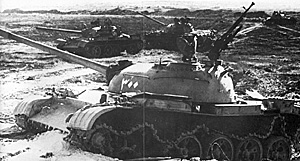 Although the self-styled military analysts of the news
media were quick to conclude that the tank as a weapon
system was "dead" immediately after the conclusion of
the Fifth Arab-Israeli War (the Yom Kippur War) in
October, 1973, they failed to note that the initial Arab
advances and the final Israeli counter-thrusts were
achieved through the use of large numbers of a "dead
weapon" the tank.
Although the self-styled military analysts of the news
media were quick to conclude that the tank as a weapon
system was "dead" immediately after the conclusion of
the Fifth Arab-Israeli War (the Yom Kippur War) in
October, 1973, they failed to note that the initial Arab
advances and the final Israeli counter-thrusts were
achieved through the use of large numbers of a "dead
weapon" the tank.
Perhaps these analysts were surprised by the number of tanks that the combatants were resupplied with during and after the War, for if the observers thought the tank was obsolete, the participants still believed that tanks were a necessary component of their arsenals. Perhaps this was only a display of the persistence of out-moded thought patterns among the military hierarchy on both sides. But as the Jews cannot afford the luxury of such an error, and the Arabs would certainly welcome a weapon system less complex than the tank, it is more logical to assume that the tank still has a vital mission to fulfill on the battlefield at present and will continue to do so in the future.
Accepting the necessity of the tank in contemporary warfare, the next question is, how effective is the tank, and more specifically, how effective were the main battle tanks employed by both sides during the October War?
The basic criteria in tank evaluation is how successful a tank is on the battlefield. Success would be determined by the tank's ability to fulfill its mission, and its mission may be essentially defined as destroying all major battlefield targets within visual range. As the most difficult target to engage is a hostile tank, the simplest and meet satiefactory primary criterion of tank effectiveness a tank's probability of success in destroying hostile tanks.
Because a tank is not an aggregate of individual components, a comparison of characteristics such as gun caliber, speed, and weight, while valuable, is unsatisfactory for purposes of evaluation because all of these characteristics must be integrated. It is the manner of their integration that determines a tank's effectiveness.
The three traditional concepts of "firepower, "mobility," and "protection," upon examination prove to be somewhat imprecise as aspects of one concept will often overlap with and therefore affect aspects of the other two. A better conceptual triad is that of destructiveness, survivability, and availability.
- DESTRUCTIVENESS is defined as the tank's ability to
acquire, engage, and destroy a hostile tank.
SURVIVABILITY is the tank's capacity to avoid destruction.
AVAILABILITY is a tank's capability to be where it is required at the time it is required.
Keeping these factors in mind, a more useful discussion of the effectiveness of the main battle tanks employed in the Yom Kippur War is possible.
More Arab-Israeli Armor 1973
-
Arab-Israeli Armor 1973: Introduction
Arab-Israeli Armor 1973: T-54/55/62
Arab-Israeli Armor 1973: M-48/60
Arab-Israeli Armor 1973: Centurion Mk 5
Arab-Israeli Armor 1973: TO&E
Arab-Israeli Armor 1973: Jewish Tank Markings
Arab-Israeli Armor 1973: Tanker Crew
Arab-Israeli Armor 1973: Comparative Data (Chart)
Arab-Israeli Armor 1973: Comparative Ammunition
Arab-Israeli Armor 1973: Observations and Conclusions
Arab-Israeli Armor 1973: Paper Tanks
Arab-Israeli Armor 1973: Bibliography
Arab-Israeli Armor 1973: Glossary of Terminology
Arab-Israeli Armor 1973: 1/64 Scale Illustrations (extremely slow: 439K)
Back to Conflict Special Study 1 Table of Contents
Back to Conflict List of Issues
Back to MagWeb Master Magazine List
© Copyright 1975 by Dana Lombardy
This article appears in MagWeb (Magazine Web) on the Internet World Wide Web.
Other military history articles and gaming articles are available at http://www.magweb.com